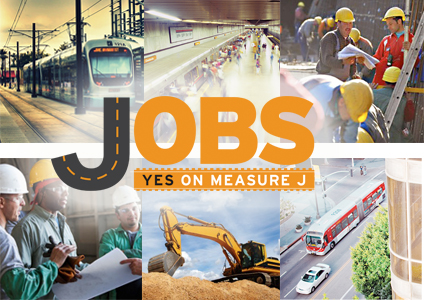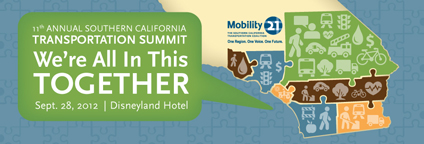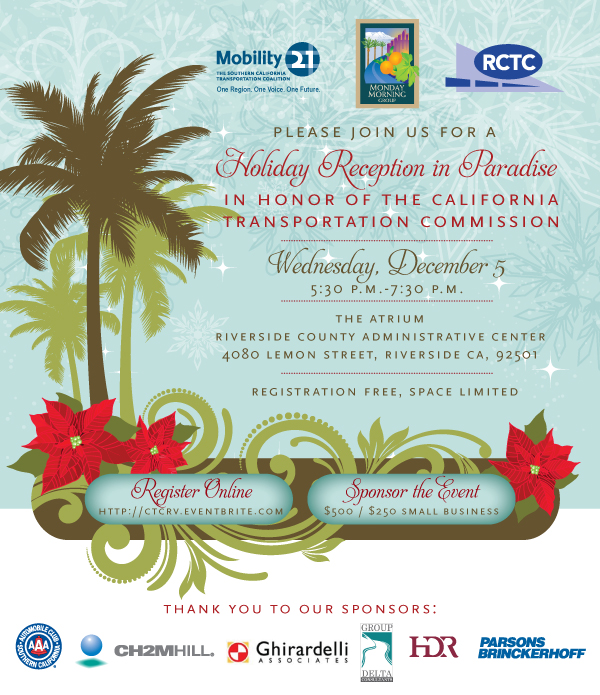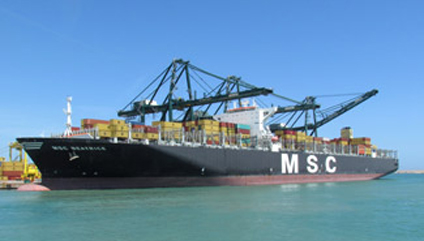Mobility 21 Urges Support
for LA County’s Measure J
With the election less than two weeks away, the final push to support Los Angeles County’s ballot initiative to extend the half-cent sales tax for transportation is in full swing.
In 2008, Los Angeles County voters approved a 30-year half-cent sales tax to provide local resources to finance new transportation projects and advance those already in the pipeline. However, not all projects are fully funded and some won’t be completed until the end of the 30 year period. Measure J on the November ballot would extend the sales tax for another 30 years, to 2069.
The passage of Measure J would allow Metro to bond against the forecasted revenue generated during the additional 30 years and accelerate the construction of up to seven transit and eight roadway projects. Click here to view the project map.
Mobility 21 urges Los Angeles County residents to pass Measure J because at a time when construction costs are low and unemployment is high, these traffic relief projects would accelerate the creation of thousands of jobs. The projects would begin construction within five years and be completed in about 10, providing Los Angeles County with traffic relief and new transportation choices. The projects would create more than 400,000 jobs, with more than 250,000 of them accelerated into the first decade.
Your support these last few days before the election is critical to help make sure Los Angeles County votes “yes” on Measure J. Join the below construction and engineering firms by standing up for jobs today.
Did you support the campaign but don’t see your firm listed? Let us know and we’ll add your logo to our website.
Summit Videos and Photos Now Online
Did you miss Mobility 21’s 2012 Transportation Summit on Sept. 28? Check out the online content, including videos and presentations of thegeneral and breakout sessions from V-cube, videos of our deservingaward recipients from MBI and a video recapping the day from Consensus Inc. Don’t forget to visit Mobility 21’s Flickr page to view the photos from the Summit.
Thanks for sharing your feedback on the Summit. We’re always looking for ways to improve the conference. We’d love to hear your ideas! Pleasesend us an e-mail to share your thoughts.
- 81 percent of survey respondents rated the overall Summit between an 8 and 10, with 10 being the highest score
- 91 percent of respondents strongly agreed or agreed they liked the Disneyland Hotel venue for the Summit
- 93 percent of respondents strongly agreed or agreed that the Summit was well-organized
Save the date!
The 2013 Mobility 21 Summit will be held on Tuesday, Oct. 29 at the JW Marriott at L.A. Live.
Jeff Morales on New Approach
to California’s High-Speed Rail Project
 This month, CEO of the California High-Speed Rail Authority Jeff Morales discusses the revised Business Plan, blended approach and private sector involvement in the California High-Speed Rail project.
This month, CEO of the California High-Speed Rail Authority Jeff Morales discusses the revised Business Plan, blended approach and private sector involvement in the California High-Speed Rail project.
M21: The revised California High-Speed Rail Authority’s 2012 Business Plan emphasizes a blended approach to building high-speed rail. Briefly describe this plan and the advantages of such an approach.
JM: Governor Brown asked us to reset our approach to high-speed rail in 2011. He gave clear direction that benefits needed to be delivered sooner, costs needed to be reduced and we needed to define a more effective design approach that made sense for California. With new leadership on the Board, the Authority looked to transportation experts, regional leaders and the international community to develop a new vision for high-speed rail and for the state as a whole – California would be the first state in the nation to have a fully integrated transportation network that incorporated high-speed rail.
To achieve this, we developed the blended approach as the cornerstone of our Revised 2012 Business Plan. This meant upgrading existing regional rail services in the short-term so that our high-speed trains are able to run on them in the future. Not only do we reduce costs by eliminating elaborate infrastructure, but we provide immediate benefits to all regions of the state. These upgrades will build ridership along the high-speed rail corridor and allow the system as a whole to connect the majority of the state in a new way. There’s a long list of benefits associated with this approach including job creation, economic development, enhanced intermodal transportation opportunities, smart growth and a cleaner environment.
M21: What are the Authority’s current plans for implementation of this approach in Southern California?
JM: In April, the Authority Board began the process of entering into a Memorandum of Understanding (MOU) with the Southern California Association of Governments, Metro, San Bernardino Associated Governments, Riverside County Transportation Commission, San Diego Association of Governments, Metrolink and the City of Anaheim to implement the blended approach in the Southland. The main goal of this MOU is to improve connectivity in Southern California now to make way for future connections to the high-speed rail line. This effort is very compatible with local and regional plans to improve mobility and features of the plan include upgrading Metrolink, improvements at Union Station and a variety of safety, double track and grade separation enhancements across the Southland. Key to this MOU is $500 million in high-speed rail funds, appropriated in Senate Bill 1029, that will be used with a one-to-one match to complete $1 billion worth of improvements in advance of the high-speed rail line reaching the area. This will help connect the region and increase transit ridership now and enhance high-speed rail ridership later.
Proposition 1A, the ballot initiative that authorized bonds for high-speed rail, set aside $950 million in bonds for projects to enhance connectivity to the high-speed rail system. These monies will go to transportation projects throughout Southern California including LA’s Regional Connector, run-through tracks at Union Station and enhanced safety systems on the Pacific Surfliner, to name a few. It is estimated that investing $950 million results in over $4 Billion in total investment across the state in vital transportation projects.
M21: What response has the high-speed rail project received from the private investment community regarding the financing of the project?
JM: There is a very strong interest from the private sector in participating in our program. It will be privately operated, and we will take advantage of private sector innovation through design-build contracting. It is important to note, and often not fully recognized, that the state does not plan to operate the system, but rather will rely on the private sector to maximize the efficiency. The other upside of this approach is that the proceeds of this deal can then be used to fund additional construction segments in order to complete the entire Initial Operating Section (IOS) from the Los Angeles area to San Francisco.
Other opportunities for private sector involvement include leasing our right-of-way for fiber-optic cables or energy uses, Transit Oriented Development (TOD) around our stations, advertisements and station naming rights. We’re looking to local transit agencies as well as international operators for ideas on how to maximize our opportunities to creatively partner with the private sector.
In addition, development of high-speed rail technology could fuel a new tech boom in California. In order to bring best practices to the state the Authority already has cooperative agreements (MOUs) with 9 countries. All of these countries have already built high-speed rail systems. The non-binding cooperative agreement initiates the exchange of information between California and the various countries to establish and develop a long-term cooperation in the field of high-speed rail transportation.
Authority Board Members have been reaching out to investors and will engage Wall Street to find out what other options there might be for private investment. We have already received letters of interest and official visits from numerous large multi-national firms as well as governments around the world who already understand the development potential of this project and are keenly interested in investment opportunities as they become available.
M21: At what point, if at all, has the private sector been included in the design of the project?
JM: Rather than a traditional public works project, high-speed rail is a joint public-private partnership. We have already seen many benefits associated with this arrangement as the creativity and nimbleness of the private sector have been fully incorporated into all aspects of the project. Overall the Authority utilizes a private Program Management Team to support the delivery of this project. To complete the Project’s Alternative Analysis and Environmental Documentation work the Authority divided the project up into segments and contracted with private firms to provide the planning and engineering services required to complete these documents. Moving forward into construction the Authority will utilize the Design-Build method of delivery to construct the project segments as they are environmentally cleared. We will hire a separate Construction Management firm to oversee the construction work and ensure compliance with all contract documents and rules and regulation governing construction. Both the Construction Management and Design-Build procurements for the first segment have been advertised and we are looking forward to receiving the bids/proposals for both of these contracts imminently, and awarding the contracts in 2013.
Mobility 21 to Co-host Holiday Reception for
California Transportation Commissioners
Join Mobility 21, Monday Morning Group and the Riverside County Transportation Commission for a tropical holiday reception in paradise. Network with transportation professionals and elected officials as we honor the California Transportation Commission for their dedication to keep Californians moving.
When: Wednesday, Dec. 5 from 5:30-7:30 p.m.
Where: The Atrium at the Riverside County Administrative Center
4080 Lemon Street, Riverside, CA 92501
$500 sponsorship ($250 for small businesses) includes:
- Logo on all pre-event marketing materials and dedicated event web registration page
- Logo on event signage at event
- Acknowledgement from the podium during the reception
Registration is free, but space is limited.
Today, the San Diego Freeway (I-405) is one of the most congested freeways in Orange County, carrying more than 300,000 vehicle trips in some sections each day. Traffic volumes on the I-405 are expected to increase significantly and the population is expected to grow 11 percent by 2040.
OCTA Board Selects Alternative 1
for I-405 Improvement Project
From OCTA’s CEO Weekly Update
The Orange County Transportation Authority’s (OCTA) Board of Directors selected Alternative 1 as the preferred alternative for the San Diego Freeway (I-405) Improvement Project in a vote this week.
Alternative 1 will add a single general purpose lane in each direction of the I-405 freeway from Euclid Street to the I-605 interchange to widen the I-405. The alternative passed with 12 votes in favor and four opposed.
The decision comes after 10 years of planning and months of outreach efforts that gathered feedback from communities within the project area, including Costa Mesa, Fountain Valley, Huntington Beach, Long Beach, Rossmoor, Seal Beach and Westminster.
Caltrans will select its preferred alternative in early 2013. The next steps for the project are:
- Final environmental impact report and statement in spring 2013
- Notice of Determination (NOD) and Record of Decision (ROD) in summer 2013
- Design and construction from 2015 to 2019
The megaship MSC Beatrice is 1,200 feet long, 167 feet wide and capable of carrying 13,798 container units.
Biggest Ship to Visit North America
Docks in Long Beach
Last month, the Port of Long Beach welcomed MSC Beatrice, the largest ship to visit North America.
“The new ships are bigger and greener and we’re pleased to be able to accommodate these vessels at the Port of Long Beach,” said Port of Long Beach Executive Director and Mobility 21 Advisory Board Member J. Christopher Lytle. “We’re among the few ports that are ‘big ship ready,’ and that means that we can continue to bring cargo to Long Beach in the most sustainable way possible.”
Until this year, the largest container ships serving North America had capacities of about 10,000 “TEUs,” or twenty-foot equivalent units. Ships carrying up to 12,500 TEUs began calling at the Port of Long Beach earlier in 2012, proving the Port’s ability to handle these megaships. The distinction is important for a seaport, because the trend in the shipping industry is to build larger ships. These ships are more efficient and greener – the bigger loads mean less fuel is expended per container.
Built in South Korea in 2009 and operated by the Mediterranean Shipping Co. of Switzerland, the Beatrice is the latest of the new generation of big container ships to be put into service on U.S.-Asia trade routes.
Larger ships are more cost-effective for ocean carriers and reduce impacts on the environment by decreasing diesel consumption. However, few ports in the world have navigation channels deep enough to handle these massive ships. The Port of Long Beach’s main channel is 76 feet deep, the deepest in North America.
The Port of Long Beach is one of the world’s premier seaports, a primary gateway for trans-Pacific trade and a trailblazer in innovative goods movement, safety and environmental stewardship. With 140 shipping lines connecting Long Beach to 217 seaports worldwide, the Port handles trade valued at $155 billion each year and supports hundreds of thousands of jobs in Southern California.
VCTC Takes Home National AdWheel
Award for Student Rider Guider
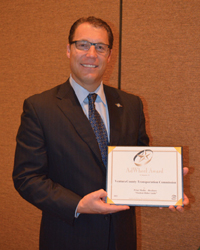 From VCTC’s On the Move newsletter
From VCTC’s On the Move newsletter
When the Ventura County Transportation Commission (VCTC) Teen Council first developed its Student Rider Guide, the goal was to provide clear and comprehensive transit information to youth in the Ventura County. The American Public Transportation Association (APTA) saw it as something more – one of the top marking and communication pieces in its ridership category.
VCTC was presented with a 2012 AdWheel Award at the APTA Convention in Seattle on Oct. 1, recognizing the Student Rider Guide as the top brochure in the “Print” category. VCTC Executive Director and Mobility 21 Board Member Darren Kettle accepted the honor.
Awards were presented in five primary categories: print, electronic media, campaigns, social media and special events. Winners were chosen from a nationwide pool of contestants within the same ridership range. The Student Rider Guide is available at a variety of community centers and in schools around the county.
![]()
2012 Riverside / San Bernardino
Economic Forecast Conference
Join Beacon Economics for the 2012 Riverside / San Bernardino Economic Forecast Conference on Thursday, Dec. 6. The program will feature Beacon Economics’ Principal Christopher Thornberg and Director of Economic Research Jordan Levine. The conference will address questions about the region’s economic future, including:
- What’s next for the Riverside/San Bernardino, California, and U.S. economies?
- Where are housing prices heading and how fast will they get there?
- Employment is recovering slowly in Riverside/San Bernardino. What is the latest jobs forecast for 2013?
- What does the European debt crisis mean for California trade activity?
- Which of Riverside/San Bernardino’s industries are poised for growth?
- Consumers are spending again, but are they saving?
Thursday, Dec. 6
Doubletree by Hilton Hotel – Ontario Airport
More info | Register
Special discount pricing for Mobility 21 members:
Enter discount code mobrsb12 when registering
California Maritime Leadership Symposium
The 13th Annual California Maritime Leadership Symposium (CMLS), scheduled for Feb. 20-21, 2013 at the Sacramento Convention Center, has become one of the premier events focused on briefing Sacramento’s policymakers on key matters related to the entire Maritime Transportation System. It is the only comprehensive forum for port executives, commissioners and other stakeholders across the state to seek resolution to the growing challenges the Maritime Transportation System faces. The California Maritime Leadership Symposium is hosted by a broad-based Coalition of the maritime industry headed up by the California Association of Port Authorities, California Marine Affairs and Navigation Conference, California Marine and Intermodal Transportation System Advisory Council, California Maritime Academy, Harbor Association of Industry and Commerce and the Propeller Club of Los Angeles – Long Beach.
Feb. 20-21
Sacramento Convention Center
More info | Register
TRANSPORTATION EVENTS IN THE COMMUNITY
Tuesday, Oct. 30
CMAA So Cal: Measure J
More info | Register
Thursday, Nov. 1
BDA-OC: Measure J Luncheon Featuring Art Leahy
More info | Register
Thursday, Nov. 1
CMAA So Cal: Construction Law Basics
More info | Register
Nov. 7-9
California Transit Association: Annual Fall Conference and Expo
More info | Register
Thursday, Nov. 8
WTS-LA: Annual Scholarship & Awards Dinner
More info | Register
Nov. 11-13
Self-Help Counties Coalition: Focus on the Future Conference
More info | Register
Wednesday, Nov. 28
WTS-IE: Comprehensive Look at Transit and Rail Projects in San Bernardino County
More info | Register
Thursday, Nov. 29
OCBC: Turning Red Tape Into Red Carpet Awards
More info | Register
Wednesday, Dec. 5
Mobility 21, Monday Morning, RCTC: CTC Reception
Register | Sponsor
Thursday, Dec. 6
WTS-OC: Annual Scholarship & Awards Gala at Disney’s Grand Californian
Thursday, Dec. 6
Beacon Economics: 2012 Riverside/San Bernardino Economic Forecast Conference
More info | Register
Thursday, Jan. 24
WTS-IE: Annual Scholarship & Awards Gala
Feb. 20-21
California Maritime Leadership Symposium
More info | Register
June 24-27
Alternative Clean Technology Expo: Washington, D.C.
More info

